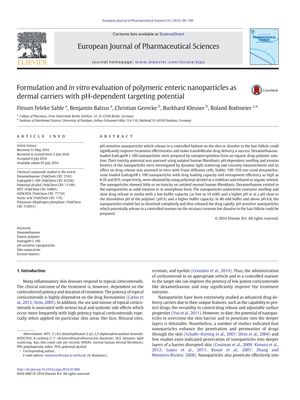TLDR Scientists created tiny particles that release medicine on the skin and in hair, working better at certain pH levels and being safe for skin cells.
In a study from 2016, researchers developed pH-sensitive dexamethasone-loaded Eudragit® L 100 nanoparticles designed for controlled drug release on the skin and in hair follicles. These nanoparticles, ranging from 100–550 nm in size, were created using nanoprecipitation and exhibited high drug loading capacity (8.3%) and entrapment efficiency (85%). The formulation was found to be minimally toxic to human fibroblasts. The release of dexamethasone from the nanoparticles was dependent on the pH and buffer capacity of the surrounding medium, with extensive swelling and slow release in low buffer capacity and higher pH, and rapid erosion or dissolution at pH levels above 6.8 with a buffer capacity of 40 mM or higher. This indicates that these nanoparticles could effectively target drug delivery to the skin and hair follicles by responding to the pH environment.
 59 citations
,
July 2015 in “Journal of innovative optical health sciences/Journal of innovation in optical health science”
59 citations
,
July 2015 in “Journal of innovative optical health sciences/Journal of innovation in optical health science” Nanoparticles around 600-700 nm can effectively enter and stay in hair follicles for days, which may help in delivering drugs to specific cells.
 67 citations
,
January 2012 in “Biological and Pharmaceutical Bulletin”
67 citations
,
January 2012 in “Biological and Pharmaceutical Bulletin” Nanoparticles don't penetrate intact skin but can enter through pores or damaged skin.
 109 citations
,
November 2005 in “The journal of investigative dermatology. Symposium proceedings/The Journal of investigative dermatology symposium proceedings”
109 citations
,
November 2005 in “The journal of investigative dermatology. Symposium proceedings/The Journal of investigative dermatology symposium proceedings” Targeting hair follicles can improve skin treatments and reduce side effects.
181 citations
,
July 2004 in “Journal of controlled release” Smaller nanoparticles improve minoxidil absorption through hair follicles.
 9 citations
,
October 2018 in “Elsevier eBooks”
9 citations
,
October 2018 in “Elsevier eBooks” Nanotechnology is improving drug delivery and targeting, with promising applications in cancer treatment, gene therapy, and cosmetics, but challenges remain in ensuring precise delivery and safety.
2 citations
,
April 2023 in “Polymers” The study created 3D-printed pills that effectively release a hair loss treatment drug over 24 hours.
 33 citations
,
February 2021 in “Advanced Pharmaceutical Bulletin”
33 citations
,
February 2021 in “Advanced Pharmaceutical Bulletin” Transdermal drug delivery systems are effective and promising for future use.
1 citations
,
February 2023 in “Pharmaceutics” New UVA-responsive nanocapsules effectively kill microorganisms in hair follicles when activated by light.
 1 citations
,
August 2023 in “Advanced Drug Delivery Reviews”
1 citations
,
August 2023 in “Advanced Drug Delivery Reviews” Microneedles are promising for long-acting drug delivery and can improve patient compliance, but more data is needed to confirm their effectiveness.






